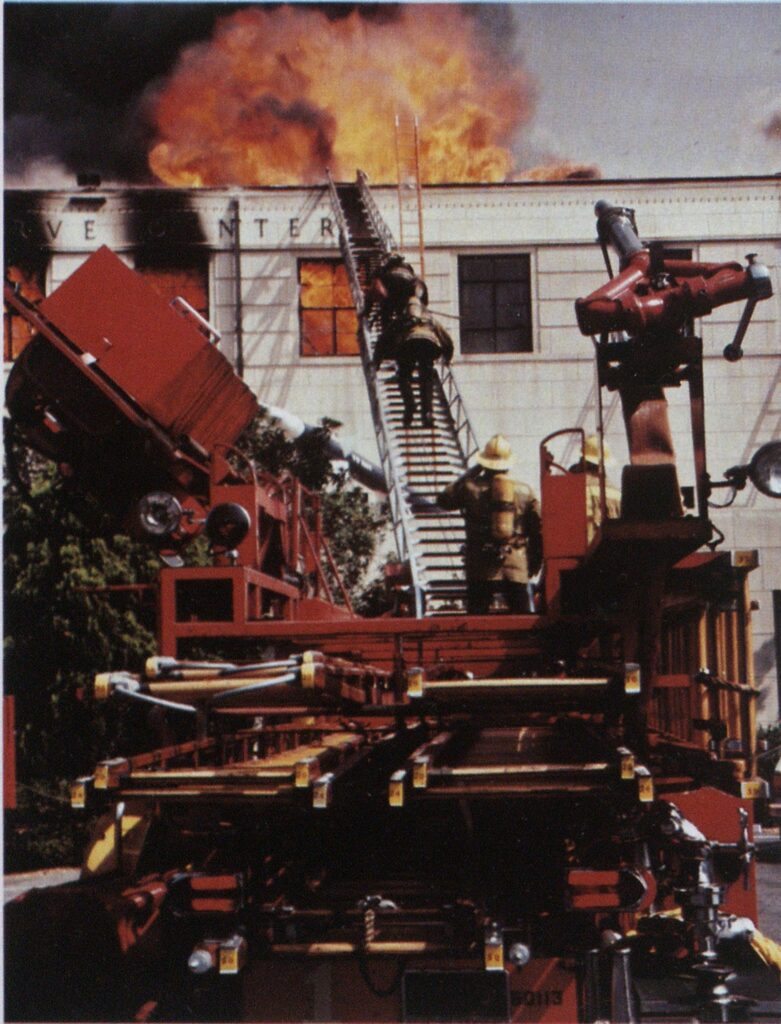
Fire Fighter Dies in Fall Through Roof At L.A. Blaze
features

Photo by Alan L. Simmons, Burbank Fire Dept.

Photo by Mike Meadows
A delayed alarm contributed to a major fire that almost destroyed the more than 40-year-old Naval and Marine Corps Reserve Center in the Chavez Ravine area immediately adjacent to Los Angeles Dodger Stadium.
Fire Fighter Frank Hotchkin of Los Angeles Station 1 was killed when he fell through the roof of the fiercely burning 250 X 150-foot structure used for reserve training at 1700 Stadium Way.
Forty city fire companies were dispatched to the fire.
About 9:05 a.m. last Sept. 27, a guard noticed “steam” coming from a roof ventilator, but he thought this was routine. At approximately 11:13 a.m., a maintenance worker saw smoke. A telephone report was made to L.A. City Operation Control Division.
At 11:19 a.m., OCD dispatched Engine 6, Task Forces 4 and 3, and Battalion 11 Chief Guy Smith.
Two task forces called
At 11:22 a.m., responding Engine 6 saw smoke boiling out of the roof area and immediately called for two additional task forces. Task Forces 11 and 1, Division 1 Commander Ed Burns, and Battalion 1 Chief Marc Mitchell were dispatched.
At 11:25 a.m., Smith requested an additional task force and a truck. Task Force 17 was assigned as its two engines have 2000-gpm pumps, which proved invaluable in providing the required fire flow.
As Engine 6 did not lay in because the nearest hydrant on Stadium Way was 1250 feet from the building entrance. Engine 6 immediately radioed for Task Force 4 to respond to Lilac Terrace, the street at the rear of the armory, and requested a security guard to open the gate so the units could lay in.

Photos by Mike Meadows

The Engine 6 crew used a line from the tank and also a wet standpipe in an effort to control the now obvious attic fire.
Smith ordered the truckmen to the roof for ventilation and two 35-foot ladders were raised. Shortly afterward, TF 1 raised its aerial and Squad 4 members also began trying to open the roof.
Hard to ventilate
“This building was well built with strong walls and ceilings and caused us all sorts of problems in both attic ventilation and ceiling pull-down,” Burns said.
“Fireman Hotchkin apparently was on his way back to the truck to pick up a pike to help break through the strong roof when he slipped and fell into the burning attic area.
“Shortly thereafter, our roof commander, Chief Clark Cornwall of Battalion 7, recommended that we abandon the roof because of the high risk. We agreed,” the division commander stated.
By now, there were adequate companies and manpower but Burns called a conference and there was serious discussion of abandoning the building and using heavy streams to contain what was left.
Roof trenched
“Our suppression and rescue officer, Chief Marc Mitchell, suggested that we go back on the roof, make a strip cut well in advance of the fire, and then use heavy lines inside in a massive attack.”
Burns said agreement was reached on this aggressive tactic. Truckmen went back to the roof using chain and rotary saws and cut the trench.
Inside, 45 fire fighters manned five 2 1/2-inch lines and, working from the east end of the building, virtually beat the fire back and out. Other crews then took l 1/2-inch lines into the pipe alley/ 3rd floor and finished it off.
“It was a difficult fire because of the type of structure and the delayed alarm giving the fire such a massive head start,” Burns commented. “I believe this operation did prove that aggressive fire fighting can be successful if properly executed.”
The chief also reported that there had been a previous electrical fire in the attic that was quickly extinguished and that specifications for repairs were out to bid.
Damage was estimated at $500,000.
Deputy Department Commander A.R. Evansen was overall commander.

